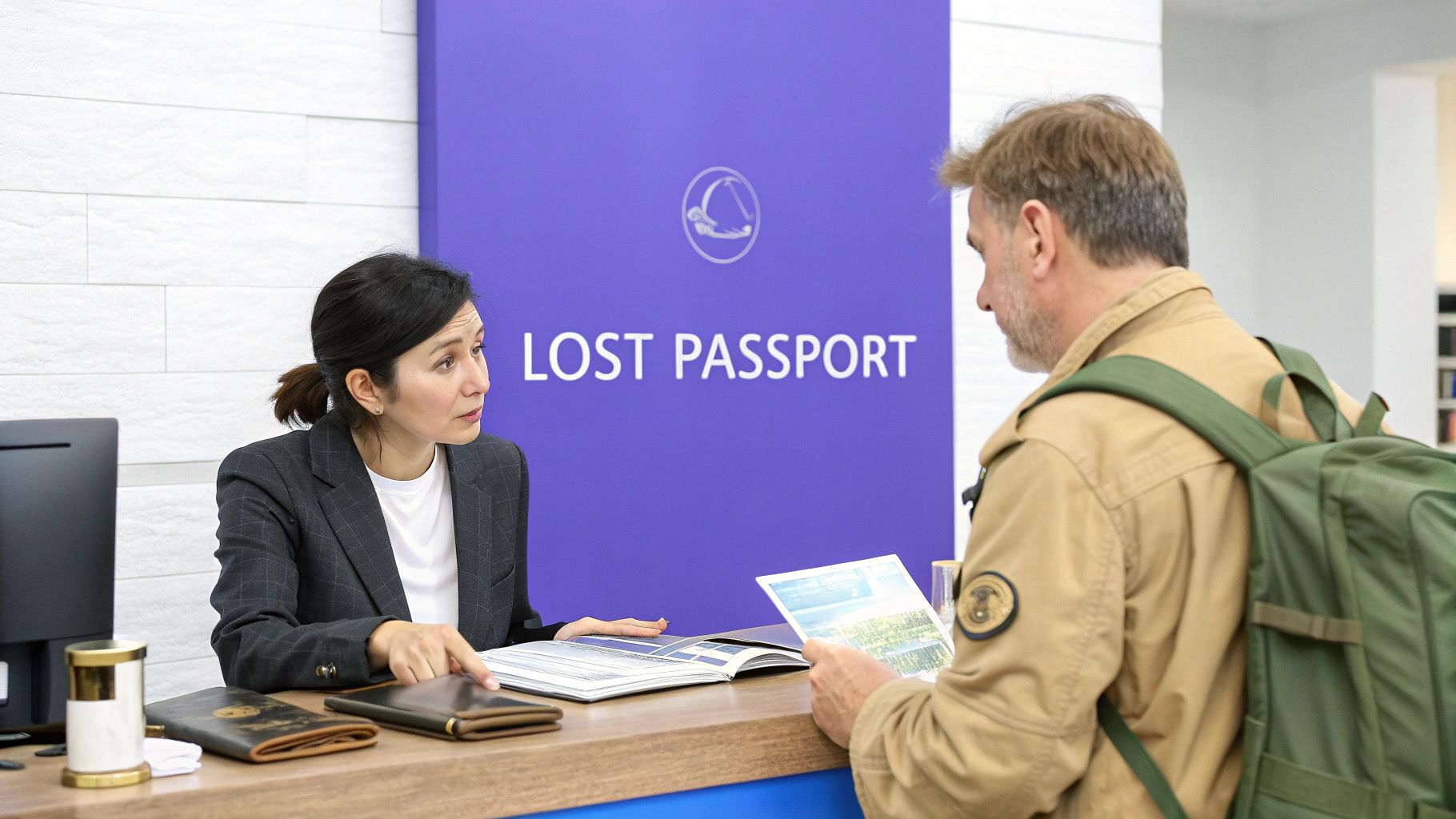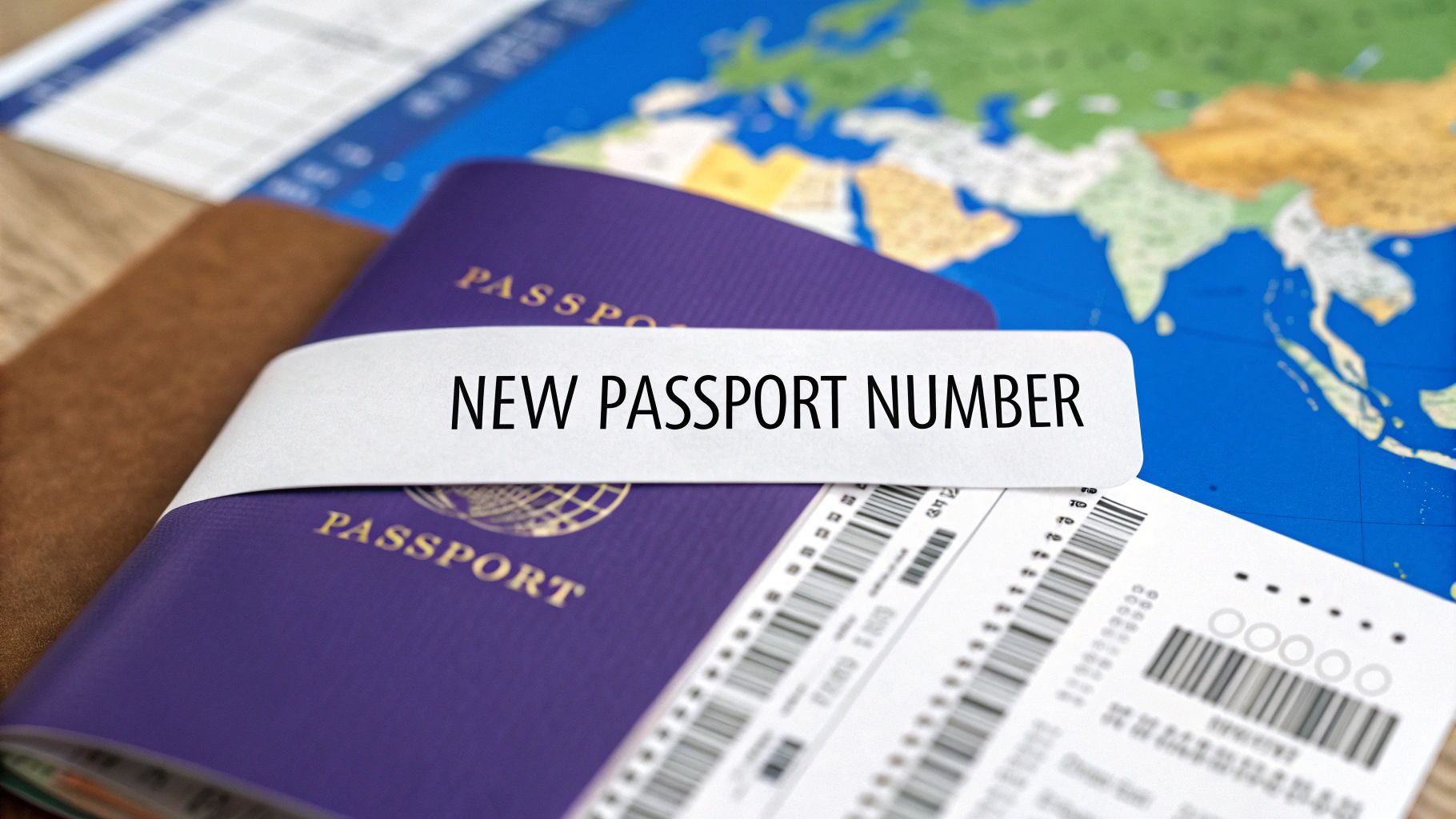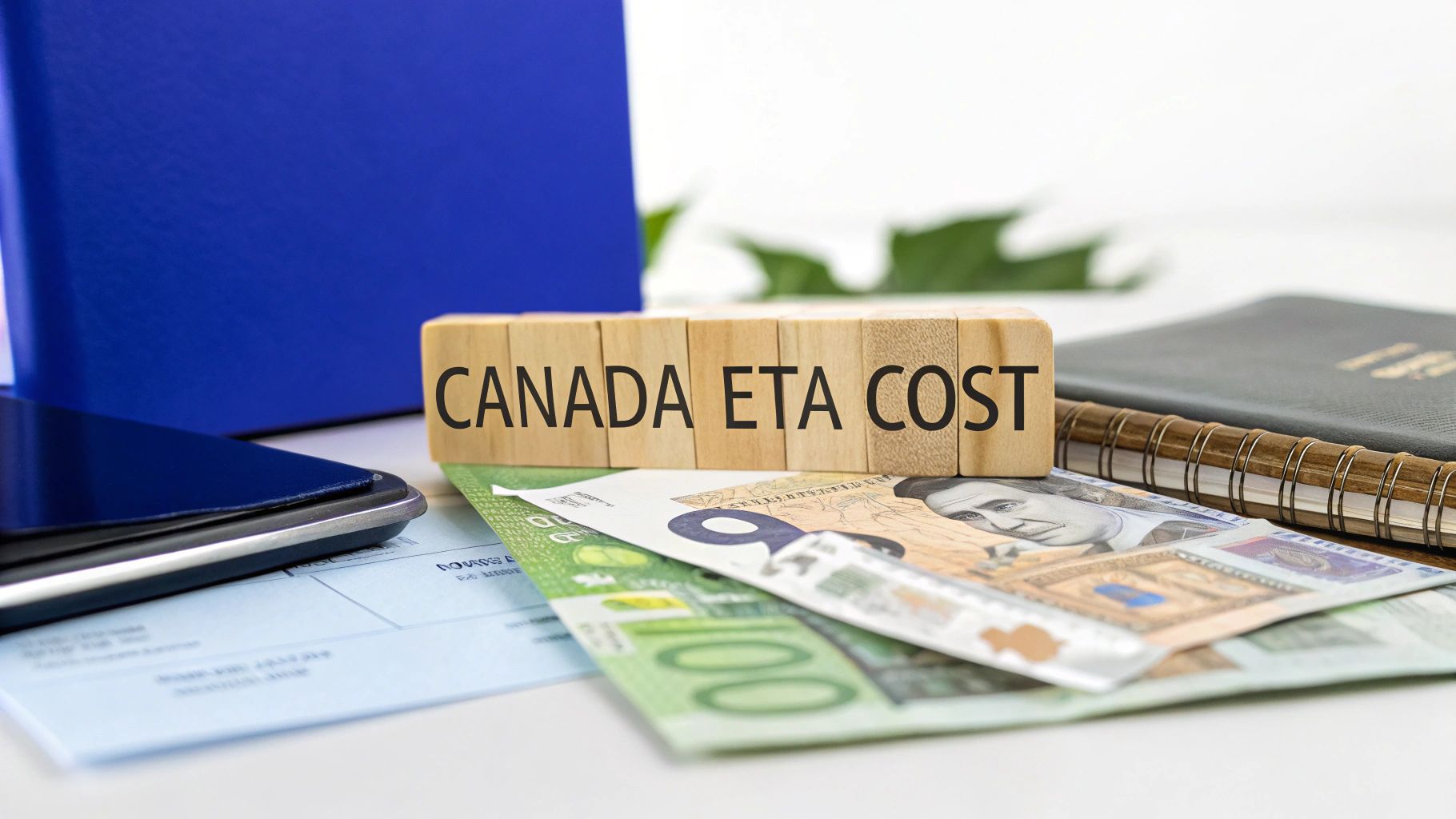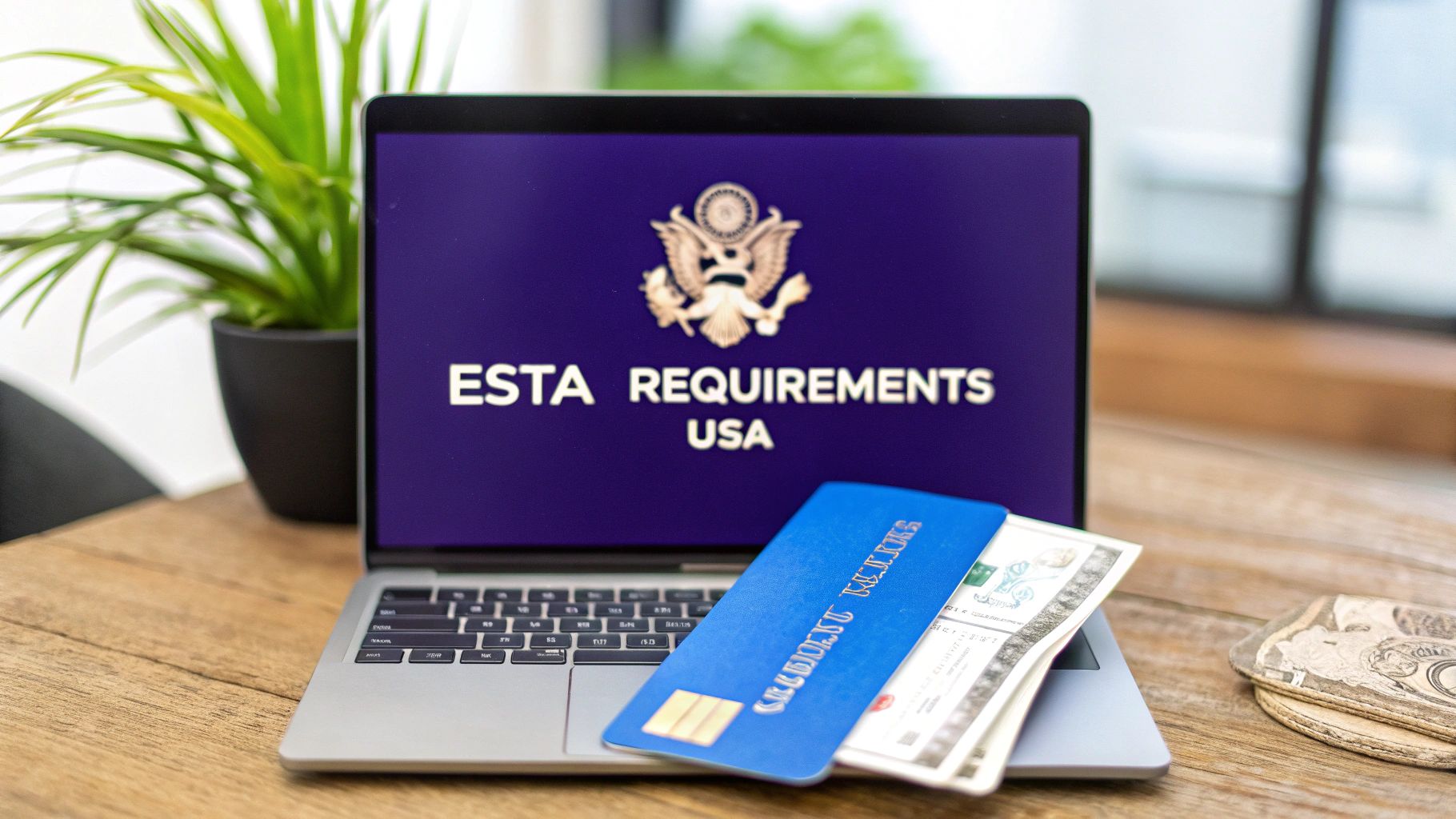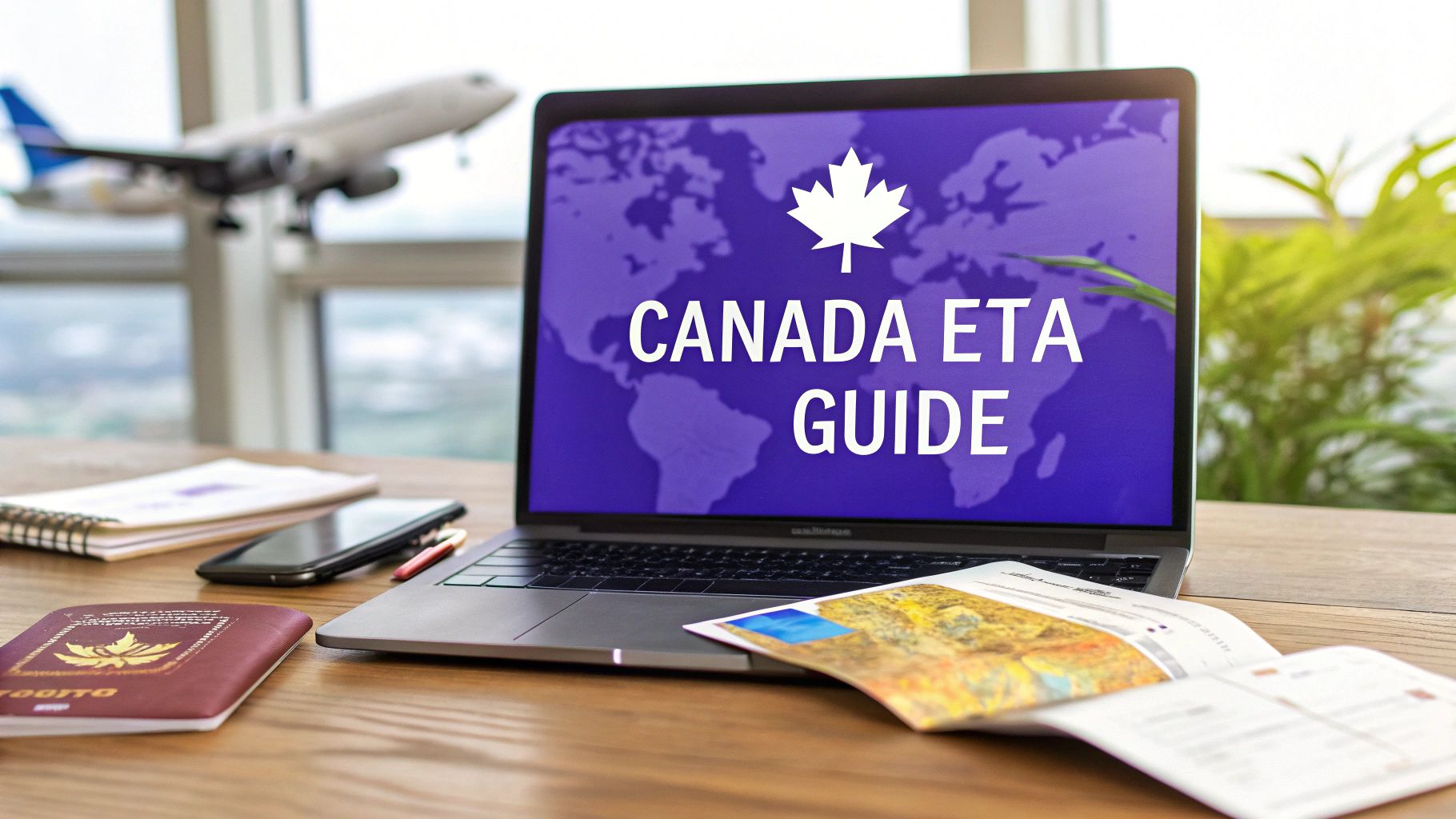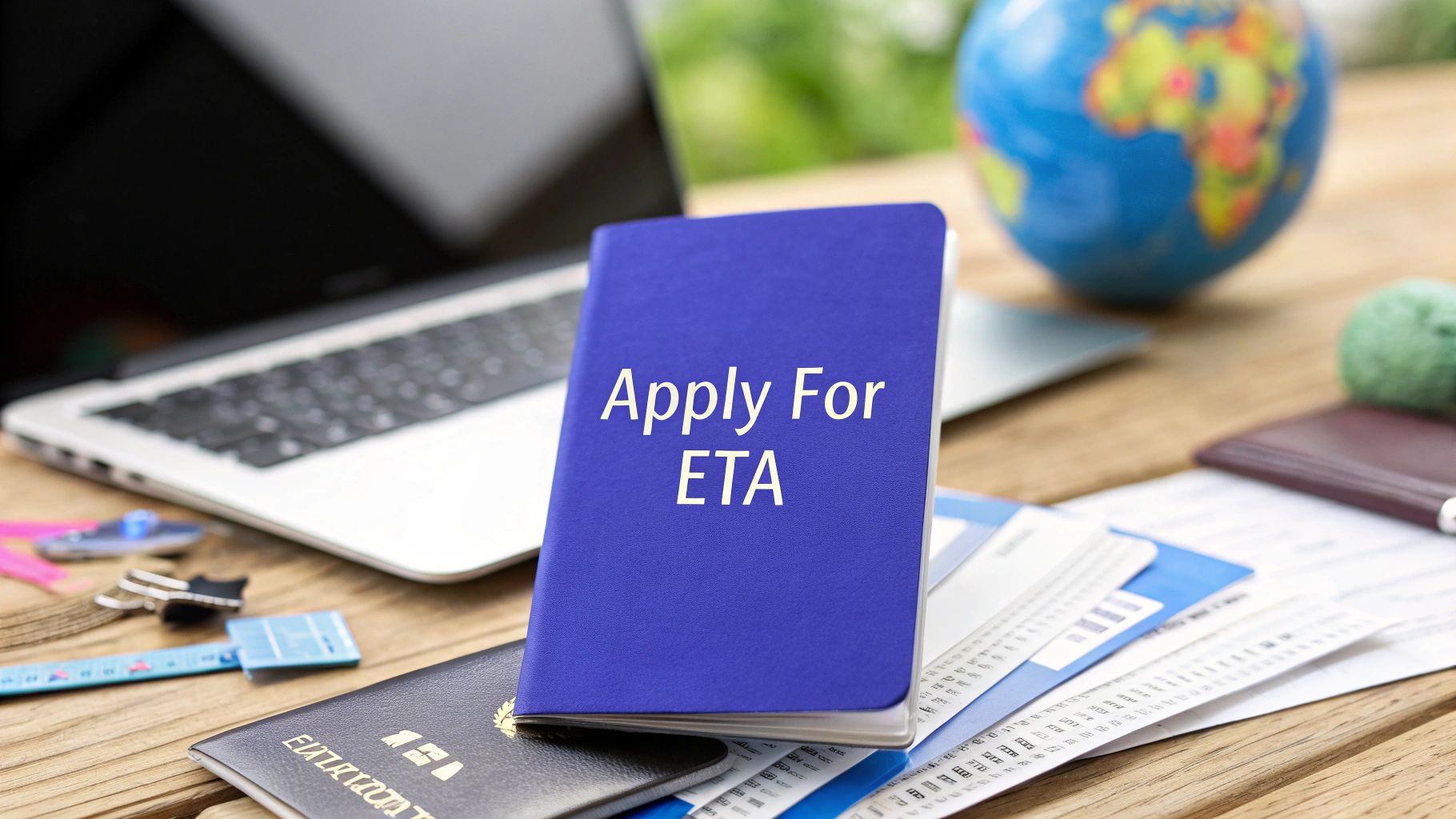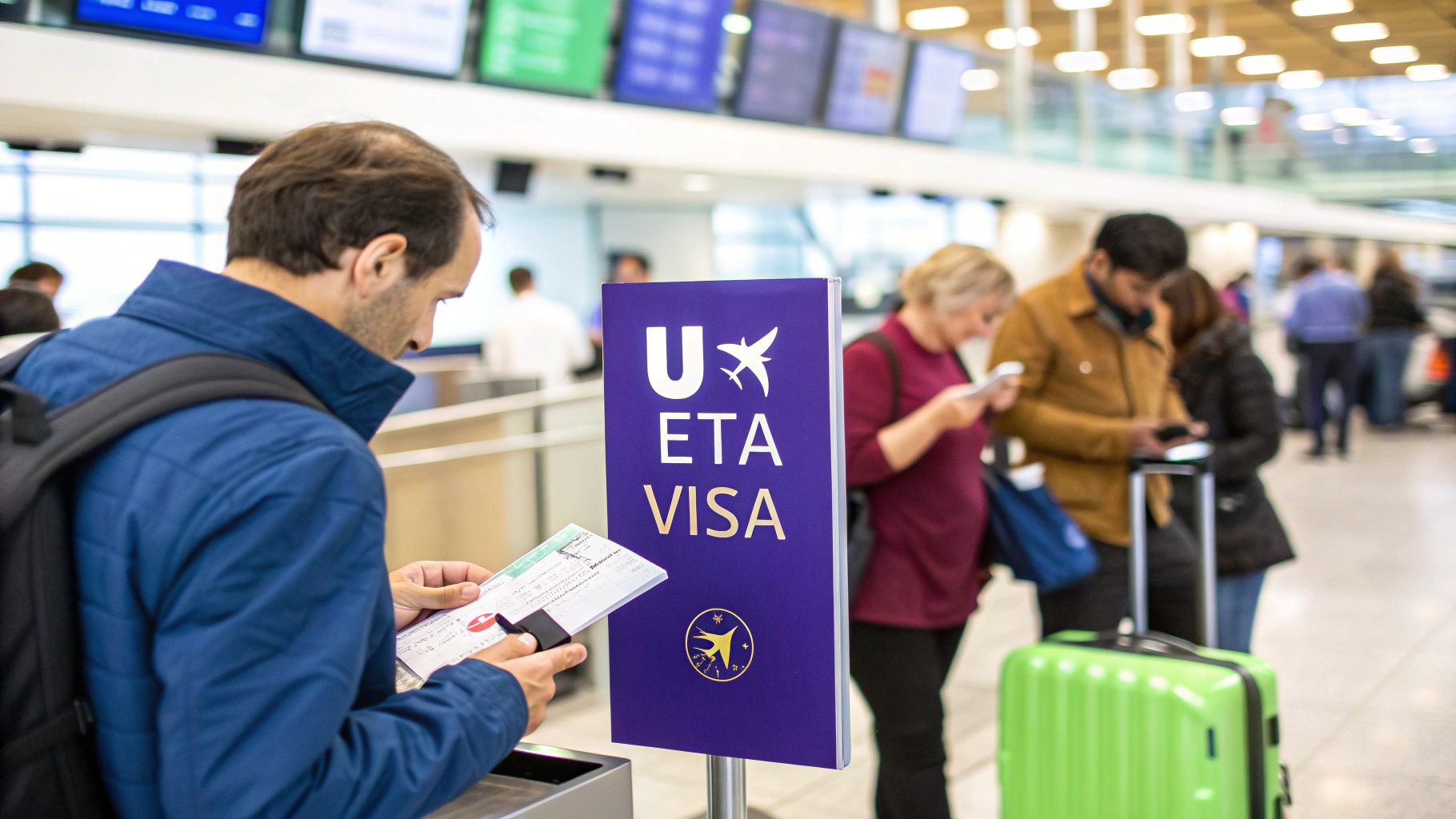
How to Prepare for International Travel
Getting ready for a big international trip is about more than just deciding what to pack. It's a structured process that touches on everything from your passport and travel authorizations to health checks and finances. The real secret? Start early. I always tell people to give themselves a good 3 to 6 months before they fly out. This gives you plenty of breathing room to get your documents sorted and book the important stuff without that last-minute panic. A solid plan is what turns a potentially stressful process into a smooth start to an amazing journey.
Charting Your Course for a Flawless Trip
A great international trip is always built on a foundation of careful planning. And let's be honest, airports are getting busier by the day, which makes being prepared more important than ever. In fact, global air travel is expected to hit a staggering 9.8 billion passengers in 2025, with international routes growing much faster than domestic ones. For us travelers, that means a higher chance of long lines and delays, making proactive planning an absolute must.
This is my tried-and-true roadmap for getting everything done on time, every time.

As you can see, spacing out the big tasks—like research, booking, and double-checking your documents—over several weeks is the key to not feeling completely overwhelmed.
Your At-a-Glance International Travel Preparation Timeline
To make this even easier, I've put together a simple timeline. Think of it as your cheat sheet for what to do and when. Breaking it down this way turns a huge to-do list into small, manageable steps.
| Time Before Departure | Key Tasks | Why It's Critical |
|---|---|---|
| 6+ Months Out | Research destinations. Check passport validity (ensure it's valid for 6 months after your return). | This gives you plenty of time for passport renewals, which can take months, and helps you set a realistic budget. |
| 3-4 Months Out | Apply for necessary visas or travel authorizations (like the UK ETA or Canada eTA). Book flights and accommodations. | Visa processing times can be unpredictable. Booking early usually locks in better prices on flights and top-rated hotels. |
| 1-2 Months Out | Schedule doctor's appointments for vaccinations. Purchase travel insurance. Plan major activities. | Some vaccination series need to be started weeks in advance. Securing insurance early protects your investment. |
| 2-4 Weeks Out | Notify your bank of your travel dates. Arrange for currency exchange. Refill any prescriptions. | This prevents your cards from being frozen for suspicious activity and ensures you have access to money and medication. |
| 1 Week Out | Confirm all reservations. Pack your bags. Make digital and physical copies of all important documents. | Last-minute confirmations catch any potential issues. Having copies is a lifesaver if your wallet or phone is lost. |
| 1-3 Days Out | Check in for your flight online. Inform family of your itinerary. Download offline maps and media. | Online check-in saves a ton of time at the airport. Keeping someone informed is a crucial safety step. |
Following a timeline like this helps you stay ahead of the game, giving you plenty of buffer time to handle any unexpected hiccups—like a delayed passport or a visa application that needs a little extra attention.
Key Milestones in Your Travel Timeline
Let's break down the most important phases.
First Things First: Documents (6-8 Weeks Out)
This is non-negotiable. The very first thing you should do is pull out your passport. Make sure it’s valid for at least six months beyond your planned return date—many countries will turn you away otherwise. Then, immediately research the entry requirements for your destination. Do you need a visa? Or a digital authorization like the Electronic Travel Authorization for UK or Canada's eTA? Get on this right away.Lock It In: Bookings and Reservations (4-6 Weeks Out)
Once your passport and visa situation is under control, it’s time to book your flights and a place to stay. I can't stress this enough: booking earlier almost always gets you better prices and far more choices, especially if you're heading somewhere popular.The Final Touches: Health and Finances (2-4 Weeks Out)
Now, focus on you. Schedule an appointment with your doctor for any required vaccinations and get your prescriptions refilled. This is also when you should call your bank and credit card companies to let them know your travel dates so they don't freeze your accounts. And please, don't forget travel insurance! It’s one of those things you hope you never need, but you'll be incredibly glad you have it if you do.
For more deep dives into travel tips and guides for specific destinations, feel free to check out our other articles on the AssistEntry blog.
Getting Your Travel Documents and Authorizations in Order
Before you start dreaming about what to pack, let's talk about the single most important part of your prep: your documents. Getting this part right is the difference between a smooth trip and a complete travel nightmare. Honestly, overlooking one tiny detail here can stop your adventure before it even begins.
Global travel is absolutely roaring back. We're talking nearly 690 million people flying internationally in just the first half of 2025, according to UN Tourism data. That means airports and border crossings are busier than ever, and having your paperwork in perfect order is non-negotiable.
Your Passport: The Foundation of Your Trip
Your passport is your golden ticket. The very first thing to do—seriously, right now—is to pull it out and check the expiration date.
So many countries have a strict six-month validity rule. This means your passport has to be valid for at least six months after the day you plan to fly home. Imagine showing up at the airport, bags packed for a London getaway, only to be turned away because your passport expires in five months. It happens way more often than you'd think.
Renewal times can be unpredictable and drag on for months, so don't put this off.
Pro Tip: Make a digital copy and a physical photocopy of your passport's main page. Store the digital version in a secure cloud drive (like Dropbox or Google Drive) and tuck the physical copy somewhere separate from your actual passport. If the original gets lost or stolen, having a copy makes getting a replacement so much easier.
Visas vs. Electronic Travel Authorizations (ETAs)
Once your passport is sorted, you need to figure out what kind of permission you need to enter your destination. Is it a traditional visa, or do you qualify for an Electronic Travel Authorization (ETA)?
This is where a lot of travelers get tripped up. ETAs aren't visas, but they are mandatory pre-clearances for people from visa-exempt countries. Two huge travel destinations that use them are the United Kingdom and Canada.
The UK ETA and Canada eTA: What You Need to Know
Planning a trip to the UK? You'll probably need a UK ETA. This system is rolling out to more and more nationalities, and you absolutely must complete your UK ETA application before you fly. Likewise, if Canada is on your list, you'll have to get a Canada eTA before you're allowed to board your plane.
These online forms seem simple, but they demand 100% accuracy. A single typo in your name, a misplaced digit in your passport number, or the wrong birthdate can get your application instantly rejected. That means you have to reapply, pay again, and risk delaying your entire trip. The info you enter must match your passport exactly.
We have a complete breakdown of this process in our guide on the Electronic Travel Authorization for Canada.
Why Getting Professional Help is a Smart Move
Let's be real—navigating official government websites can be clunky and confusing. The risk of making a small mistake with big consequences is high. This is where a third-party application assistance provider like AssistEntry.com really shines.
Using a professional service takes all the guesswork and stress out of the process. You can stop worrying about whether you filled everything out correctly and get back to planning the fun parts of your trip. To simplify your ETA application and increase your chances of approval, consider using AssistEntry — their experts guide you through the entire process, starting from just $79.
Here's what the service includes:
- Full verification: A real human reviews every detail of your application for full verification before submission.
- Error-checking and compliance review: They check for errors and ensure your application meets all government rules.
- Increased chances of approval: By catching typos and mistakes before submission, your application is far more likely to get approved the first time.
To make your travel authorization for UK or Canada dead simple, check out AssistEntry's UK ETA page or their Canada eTA page. Their experts will walk you through it, with services starting from just $79—which includes the government fee and all costs. It's a small price for total confidence that your documents are ready to go.
Managing Your Health and Safety Abroad

Let's be honest, nothing ruins a trip faster than getting sick or dealing with a safety issue far from home. A little bit of prep work on the health and safety front is the foundation of any great trip. It’s about being proactive so you can actually relax and enjoy yourself.
This all starts long before you even pull out your suitcase.
Your first move should be booking an appointment with your doctor at least four to six weeks before you fly out. Think of this as a strategic planning session, not just a routine check-up. Talk about where you're going, what you'll be doing, and get their expert advice on any necessary vaccinations or preventative meds.
Some immunizations need multiple shots spaced weeks apart, so you really can't leave this to the last minute. Your doctor will have the most current health information for your destination, making sure you’re protected.
Navigating Prescription Medications
Traveling with prescriptions requires a bit of care. The rules can be wildly different from country to country, and a common medication at home could be a restricted substance somewhere else.
To breeze through customs without any trouble, stick to these rules:
- Keep Everything in Original Bottles: Don't use a pill organizer for travel. Officials need to see the original pharmacy labels with your name and the prescription details.
- Get a Doctor's Note: Ask your doctor for a signed letter that explains your condition and why you need the medications. It’s a simple piece of paper that can save you a world of hassle.
- Pack Just Enough (Plus a Little Extra): Bring enough medication for your entire trip, plus a few extra days' worth in case of delays. Don't carry a massive supply, as that can look suspicious.
- Always in Your Carry-On: This one is non-negotiable. Never, ever put essential medications in your checked bag. If that suitcase gets lost, you're in a seriously tough spot.
Assembling a Practical First-Aid Kit
You don't need a paramedic's bag, but a small, well-stocked first-aid kit is a lifesaver for minor bumps, scrapes, and headaches. It saves you from the stress of navigating a foreign pharmacy when all you need is a band-aid or an aspirin.
A study found that up to 75% of travelers to developing countries face some kind of health issue. Most are minor, but having a kit on hand means you can deal with them instantly before they derail your plans.
Your kit should include the basics like pain relievers, bandages, antiseptic wipes, and motion sickness pills. Then, customize it with anything specific you might need, like allergy medication. A little preparation goes a long way.
Choosing the Right Travel Insurance
If there’s one thing you absolutely cannot skip, it’s travel insurance. It’s your ultimate safety net. Your regular health insurance likely won't cover you overseas, and an unexpected medical emergency could leave you with staggering bills.
When you're shopping for a policy, look past the price and get into the details. A solid plan should always include:
- Emergency Medical and Dental: This is the heart of any good policy, covering doctor's visits, hospital stays, and unexpected dental work.
- Medical Evacuation: If you get seriously ill or injured in a remote area, this covers the massive cost of transporting you to a proper hospital. It can literally save you tens of thousands of dollars.
- Trip Cancellation and Interruption: This protects the money you’ve invested in your trip if you have to cancel or cut it short for a covered reason, like a family emergency.
- Lost or Stolen Baggage: Reimburses you if your luggage gets lost, stolen, or damaged.
Read the fine print before you buy so you know exactly what’s covered. This small investment buys you an incredible amount of peace of mind, letting you explore with confidence.
Handling Your Finances for International Travel
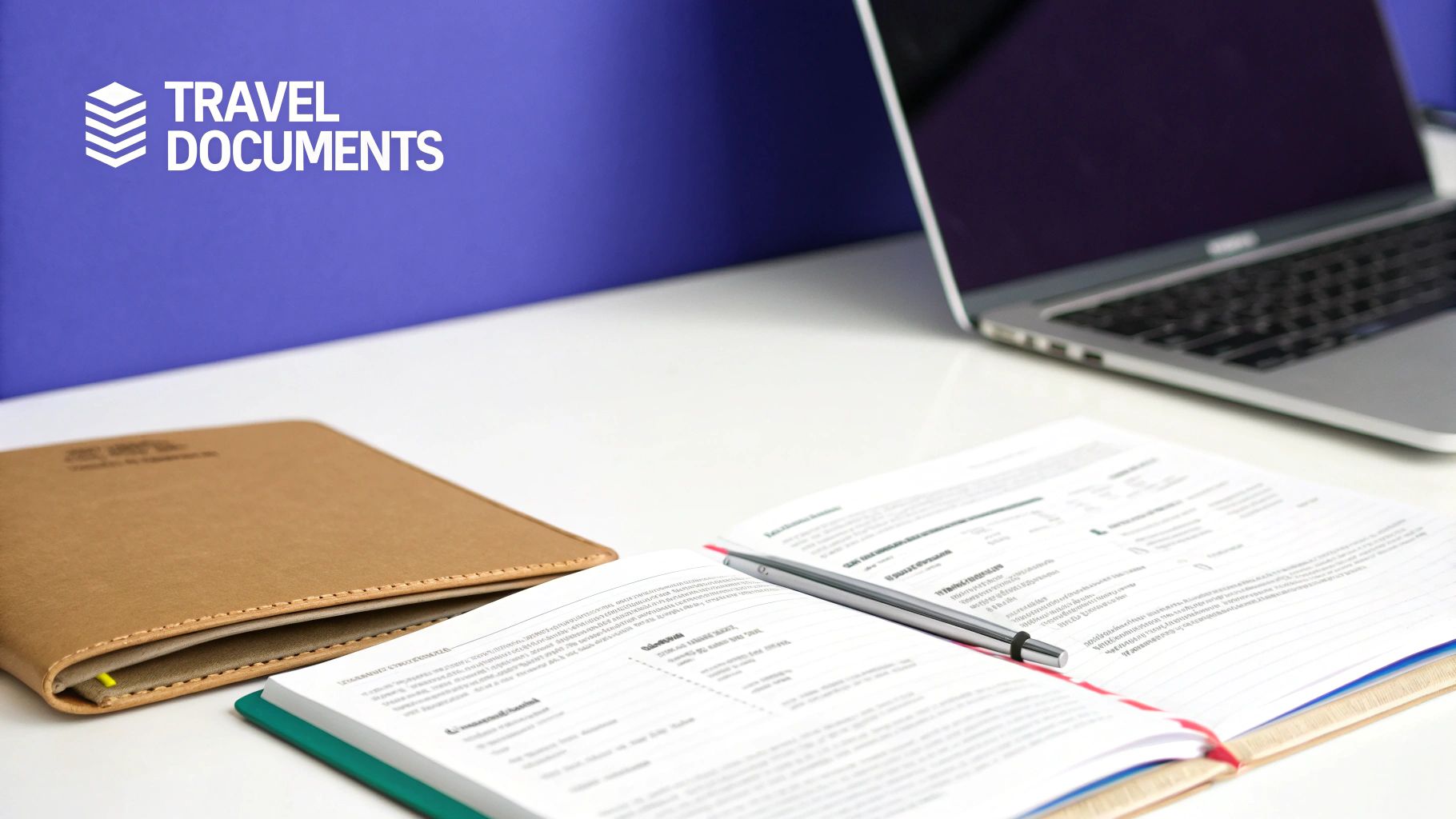
Smart financial planning is the difference between a trip you enjoy and one you just… endure. Getting your money sorted before you leave saves you from declined cards, crazy fees, and the headache of calling your bank from another time zone. A little prep work now means total peace of mind later.
It’s no secret that travel is booming. The global travel and tourism sector is expected to add a massive $11.7 trillion to the world economy in 2025. For travelers, this means popular spots will be busier and likely more expensive.
This just makes it even more important to have your finances in order, so you can focus on the adventure instead of your wallet.
Give Your Bank a Heads-Up
This is one of the easiest—and most important—things you can do. Imagine you live in Los Angeles and suddenly a charge pops up from a pub in London. Your bank's fraud department will likely freeze your account to protect you.
It’s a well-meaning security step, but it can leave you completely stranded.
A quick phone call or setting a travel notice in your banking app is all it takes. Just tell them where you're going and for how long. Problem solved.
Choose Your Payment Methods Wisely
Relying on just one card is a rookie mistake. A savvy traveler carries a mix of options to handle everything from street food stalls that are cash-only to hotels that prefer credit.
Think about what you'll need for different situations. A mix of credit, debit, and a bit of local cash is usually the winning combination.
Choosing Your Payment Method Abroad
Deciding how to pay for things abroad can feel complicated, but it doesn't have to be. Each option has its own strengths and weaknesses. The key is to have a mix, so you're prepared for any situation that comes your way.
Here’s a quick comparison to help you choose the right tools for the job.
| Payment Method | Pros | Cons | Best For |
|---|---|---|---|
| Credit Cards | Great fraud protection and good for large purchases. | Not accepted everywhere; watch out for foreign transaction fees. | Hotels, flights, rental cars, and nice dinners. |
| Debit Cards | Perfect for pulling local cash directly from an ATM. | May have daily withdrawal limits and ATM fees can add up. | Getting cash right when you land for smaller, daily spending. |
| Cash (Local Currency) | Works everywhere for small buys and is essential for emergencies. | High risk if you lose it or it gets stolen; impossible to replace. | Taxis, tips, market shopping, and anywhere that doesn't take cards. |
| Travel Money Cards | Prepaid, so it isn't linked to your main bank account for extra security. | Can have activation or reload fees; exchange rates might not be the best. | Travelers on a strict budget who want to lock in an exchange rate. |
Expert Insight: When you use your credit card, always choose to be charged in the local currency. If the machine asks if you want to pay in your home currency, say no. This trick, called Dynamic Currency Conversion, almost always comes with a terrible exchange rate and hidden fees.
Figuring out which payment methods to bring is just one part of the puzzle. Once you've got that sorted, you can focus on building a smart budget that lets you travel without the financial stress.
Master Your Travel Budget
A good budget goes beyond just flights and hotels. You need to think about the daily costs at your destination—things like food, local transport, activities, and a little extra for souvenirs or that cool tour you didn't plan for.
When you're adding up the numbers, don't forget that even required travel documents come with a fee. You can get a clear idea of what to expect by reading our guide on the UK ETA visa cost.
A simple spreadsheet or a budgeting app like Trail Wallet can help you set daily spending goals and track everything in real time. This little habit keeps you from blowing all your money in the first few days and ensures you have enough to last the whole trip.
Smart Packing and Essential Logistics
Great packing has nothing to do with bringing more stuff. It's about bringing the right stuff. When you get this down, you free yourself from the drag of heavy bags and the headache of figuring out what to wear, letting you just enjoy the moment.
The same goes for logistics. Nailing down your flights, accommodations, and local transport ahead of time is what makes a trip feel smooth and effortless. This isn't about rigid, over-planned schedules; it's about creating a flexible framework that sets you up for a great experience, whether it's a quick city break or a multi-week adventure.
The Art of Strategic Packing
Let’s get one thing straight: you don’t need to pack for every single what-if scenario. The real goal is to pack smarter, not heavier. A well-packed bag is light, organized, and filled with versatile items that all work together.
It all starts with your main piece of luggage. A rolling suitcase is a dream for city trips with paved sidewalks and hotel elevators. But if you’ll be wrestling with cobblestone streets, hopping on and off trains, or climbing endless stairs, a solid travel backpack is going to be your best friend.
Once you’ve chosen your bag, it’s time for the real magic.
Packing Cubes Are Non-Negotiable: Seriously, these little fabric organizers are a total game-changer. They compress your clothes, which saves a surprising amount of space, and keep everything neatly sorted. You can have one for shirts, one for pants, and another for underwear, so you never have to tear your bag apart just to find a clean pair of socks.
Create a Capsule Wardrobe: The secret to traveling light is packing multi-purpose clothes that you can mix and match. Stick to a core neutral palette (think black, grey, navy) and toss in a few colorful scarves or accessories to change things up. Every top should go with every bottom.
The Rule of Three for Shoes: This one is tough for some, but try to bring no more than three pairs. You’ll want a comfortable pair for walking and exploring all day, something a bit nicer for evenings out, and a practical option like sandals or boots, depending on where you're headed.
This minimalist mindset keeps you from hauling around a bunch of dead weight and, bonus, leaves more room in your bag for souvenirs.
Nailing Your Travel Logistics
With your packing sorted, it’s time to lock down the logistics that form the backbone of your trip. Getting these right is the key to avoiding stress later.
For international travel, booking your flights 2-3 months in advance is often the sweet spot for finding reasonable prices. While it’s smart to use flight comparison sites to track fares, consider booking directly with the airline. If you need to make changes or deal with a cancellation, it’s almost always easier.
When it comes to where you’ll stay, think about your travel style. Hotels offer convenience and amenities, but an apartment rental can give you a more local experience (plus a kitchen!). Always, always read the most recent reviews to make sure your expectations line up with reality.
Key Takeaway: Don't forget to plan your arrival. Know exactly how you’re getting from the airport to your hotel before you land. Whether it's a pre-booked shuttle, a ride-sharing app, or public transit, having a plan avoids that tired, post-flight confusion.
Once you’re on the ground, a flexible itinerary is your best asset. Aim for one or two "must-do" activities per day and leave the rest of your time open. The best travel memories often come from the detours you didn't plan.
Essential Tech for the Modern Traveler
Technology has made traveling so much easier, but you have to be prepared. A dead phone right when you need directions or a digital ticket is a nightmare you can easily avoid.
First, a universal power adapter is a must. Different countries use different outlets, and an all-in-one adapter ensures you can charge up anywhere. Along with that, a portable power bank is a non-negotiable for long days of exploring.
Next, get your smartphone ready for the road:
- Download Offline Maps: Apps like Google Maps let you save entire city maps to your phone. This is a lifesaver when you’re trying to navigate without a data connection.
- Organize Your Docs: Take screenshots or save digital copies of your passport, flight confirmations, hotel bookings, and your UK ETA approval to a secure cloud folder.
- Get a Local SIM or eSIM: For any trip longer than a few days, buying a local SIM or an eSIM when you arrive is almost always cheaper than paying for your home carrier's international roaming.
A smooth trip also means a smooth arrival at the border. Knowing what to expect can make the whole process feel less intimidating. To get a head start, check out our guide on what to expect at the UK border with an ETA.
Your Final Pre-Departure Checklist

The final 72 hours before you take off are less about planning and more about execution. This is crunch time, where you knock out all those small but critical tasks that make for a smooth departure. Getting these last-minute details right means you can leave home feeling calm, cool, and collected.
Your first move should be to sort out your digital logistics. Check in for your flight online the moment it opens—usually 24 hours before departure. Not only does this save you a massive headache at the airport, but it also gives you a better shot at grabbing the seat you want. While you’re at it, download your airline’s app. It’s the easiest way to get real-time flight updates and gate changes sent straight to your phone.
Final Confirmations and Communications
Once your flight is checked in, it's time for a quick round of final confirmations. Double-check your hotel booking, airport shuttle, or rental car. A quick call or email can prevent a lot of frustration after a long flight. Trust me, you'll thank yourself later.
Next, share your final itinerary with a friend or family member back home. Don't just tell them where you're going—give them the details.
- Your flight information and boarding passes
- Hotel addresses and phone numbers
- A copy of your passport and any travel authorizations (like your UK ETA)
- Your travel insurance policy details
Think of it as your personal safety net. It ensures someone always knows where you are and has everything they need in an emergency.
Traveler's Tip: Always take screenshots of your mobile boarding passes, hotel confirmations, and any digital tickets. You never know when you'll be stuck without Wi-Fi or data, and this guarantees you can access them instantly.
Finally, run through the last-minute home and packing checklist. Charge all your gadgets—phone, power bank, headphones, you name it—to 100%. Give your luggage one last weigh-in to avoid those dreaded overweight baggage fees. And don't forget the simple stuff: arrange for pet care, pause your mail, and take out the trash.
With everything ticked off the list, you're officially ready to go.
Your Top International Travel Questions, Answered
Even the most seasoned travelers have questions that pop up before a big trip. Getting clear, straightforward answers can be the difference between a stressful departure and a smooth one. Let's tackle some of the most common questions to help you get ready.
How Far In Advance Should I Really Start Preparing?
My rule of thumb? Give yourself 3 to 6 months before you plan to leave, especially if you're heading somewhere that requires more than just a passport.
This isn't about being overly cautious; it's about being realistic. Passport renewals can hit unexpected delays, and visa applications have their own timelines. Starting early gives you a comfortable buffer for these essentials. Plus, it gives you plenty of time to handle digital requirements like an Electronic Travel Authorization without any last-minute panic. Honestly, planning ahead almost always saves you money and a whole lot of stress.
Is Travel Insurance Actually Worth It?
One hundred percent, yes. It's a non-negotiable for me. A huge mistake people make is assuming their regular health insurance has them covered abroad—it almost never does. Travel insurance is your financial safety net for the unexpected.
We're talking about everything from emergency surgery after a fall to a cancelled trip because of a family emergency. It also covers things like lost bags and major flight delays. The peace of mind alone is worth the small investment.
Traveler Takeaway: Don't even think about skipping travel insurance. It’s a small upfront cost that can protect you from tens of thousands of dollars in medical bills or other trip-ruining mishaps.
What Exactly Is An Electronic Travel Authorization (ETA)?
Think of an Electronic Travel Authorization (ETA) as a digital green light. It’s a pre-screening system that countries like the UK and Canada use for travelers who don't need a full visa. While it's not a visa, it is absolutely mandatory for boarding your flight.
The whole point is to confirm you’re eligible to enter the country before you even leave home, which makes things faster at the border. Knowing how to apply for a UK ETA or Canada eTA is crucial for a smooth trip.
Be warned: the application for a UK ETA or a Canada eTA visa has to be perfect. Even a tiny typo can get you rejected, causing a domino effect of delays that could wreck your travel plans.
To get your UK ETA application right the first time and avoid mistakes, using a third-party application assistance provider like AssistEntry.com is a smart move. Their experts review your entire application to make sure it's flawless before it's submitted, with prices starting from just $79 (it includes the government fee, all costs included). They catch errors you might miss, saving you from costly mistakes and potential travel nightmares. You can learn more at AssistEntry’s UK ETA page.
